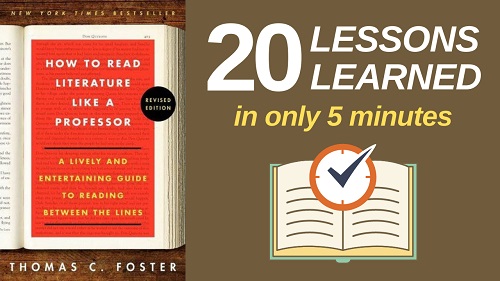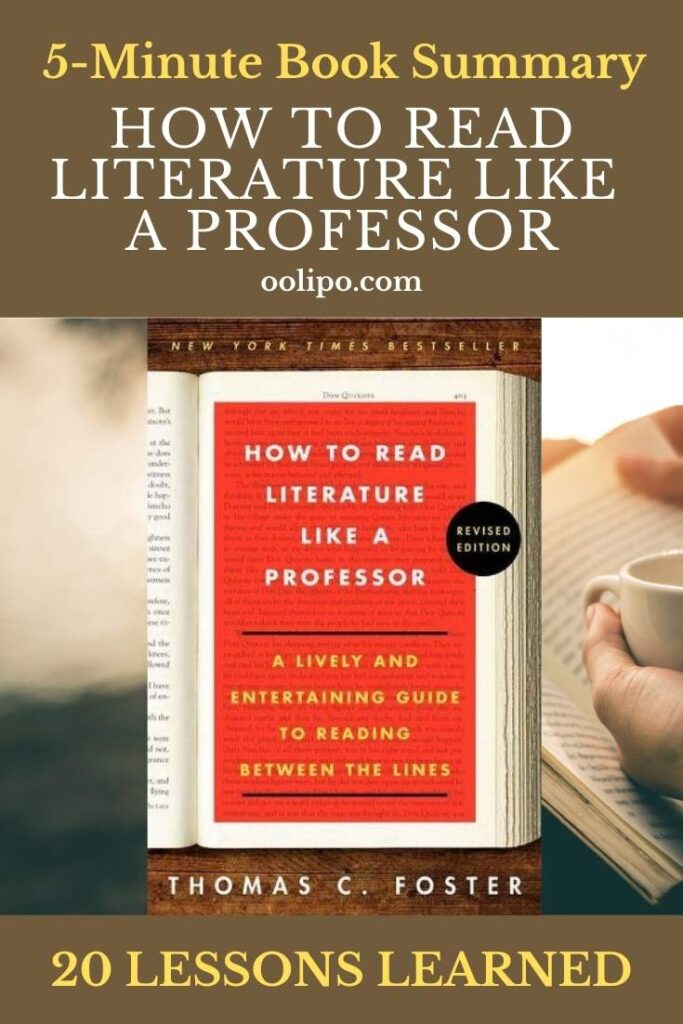How to Read Literature Like a Professor is a self-help book by Thomas Foster in 2003. The literary works you read are much more valuable than you think. But to understand how valuable a job is, you have to be well-equipped. In this How to Read Literature Like a Professor summary, we dive deep into Thomas Foster’s perspective on reading literature.
In his book, Foster gives you some ways to grasp a work in all its aspects. It is a book that you can read with pleasure with its beautiful examples.

How to Read Literature Like a Professor Summary with 20 Lessons Learned
Here are the 20 lessons to learn from How to Read Literature Like a Professor Summary:
#1 Professors and Students
By learning the correct ways to read literature, you can understand it much faster. The difference between professors and students is mastery of the subject. As you do enough reading and techniques are learned, this gap closes.
#2 Key Elements
According to the author, there are certain elements of reading language. If you have these elements, you can understand the literary work much faster and look at the subject from a wider perspective. These elements are memory, symbols, and patterns.
#3 Trust Your Memory
One of the elements that play an important role in better understanding the existing text is memory. In other words, if you have read a similar text before, your job becomes much easier. You will also need a good memory for this. Don’t worry about memory. Since literary works contain emotional subjects, they can be kept in memory more easily than technical information.
#4 Examine Symbols
Each symbol has a different meaning. If you know the meaning of the symbol mentioned in one part of the story, you can look at the literary work from a wider window. You will find much more depth and unity of meaning in the work you read.
#5 It Is Not Pointless To Patterns
Patterns are not meaningless repetitions. They express a message from the author or a theme of the work you are reading. Experienced readers pay particular attention to these patterns.
#6 Shallow Readers
The vast majority of readers cannot grasp the depth of the work. They usually focus on the surface story. They waste literary works that they could have enjoyed much more. Try to see what it offers you beyond what is described in the story you are reading. Pay attention to subtexts.
#7 Basic Structure
In novels, we read about the hero’s experiences from the beginning to the end of the story. Our hero disappears, recovers, develops, starts over. Then someone will show up to guide him. A lot of things undergo his head. This is the hero’s journey. If we are aware of this basic structure, we can understand difficult texts more easily.
#8 Hero’s Journey
In the story, it’s all about what happens to the hero as he moves towards his goal. By the way, if you have an idea to write a book, you can find resources that give very detailed information about the hero’s journey. The author has addressed this issue more fundamentally.
#9 Destination
The hero’s goal should be consistent with his story. The goal he wants to achieve throughout the whole story may not be clear at first, but once it becomes clear, we need to see that it is about his past. It should not be a mere coincidence that brought him to this point.
#10 There Must Be a Cause
There must be an irresistible reason for our hero to embark on an adventure. The journey begins as soon as our hero, who will take many risks and walk in an unknown, finds a reason for himself. Usually, you need a reason to blow your mind.
#11 Struggle
There will always be difficulties for the hero to develop himself and to provide a sense of unity to the story. As the hero struggles with these difficulties, physical and mental changes will occur in himself. Thanks to these challenges, the hero’s value increases and he become more attached to the goal unless he gives up.
#12 Message
Maybe a message will come to the hero from afar, maybe from someone right next to you. This message upsets the hero. After that point, the hero experiences a change, especially in the mental dimension. This change can make the journey more difficult or, if it’s a message that comes at the right time, it can make the hero even stronger.
#13 Common Symbols
Authors from the same culture use the same symbols with the same meanings in their stories. If the author has a similar culture to other authors whose stories you have read before, it will be much easier for you to understand their writing, notice the symbols and decipher the story.
#14 The Texts Are Interconnected
The texts you read throughout the story are written in a way that supports each other and creates meaning integrity. The rising sun may give the impression that the hero’s affairs will go well, or deteriorating weather may be a harbinger of a bad event. No line is written to be written. Each text prepares the reader and hero for the next event.
#15 Religious Symbols
Many writers consciously or unconsciously make use of religious symbols or expressions. Since religion is a common value of people, religious symbols can be used in books to be more understandable. The stories of many heroes were similar to religious miracles or the subjects were directly inspired by religious stories.
#16 Don’t Just Read With Your Eyes
Imagine reading. Make an effort to visualize what you read. Maybe it can slow down the reading speed a little bit, but it will help you understand the subject better and keep it in your mind.
#17 A World Without Borders
In the literary world, the character’s actions are limitless, but a story is never written that way. Each character’s traits and adventures are consistent within themselves. So if something unexpected is going to happen in the story, it may come as a surprise to you, but it’s not unreasonable.
#18 Colors
For example, how do you visualize an angel in front of your eyes? White? But how do you revive a demon? Red or black? Many of us are used to these colors. Writers take advantage of this situation, namely the power of colors, to make their stories more understandable.
#19 Unwavering Rules
As mentioned earlier in this How to Read Literature Like a Professor summary, there are no rules that cannot be violated in novels, including gravity. Of course, these rules are mostly changed for the hero. However, if there is the slightest inconsistency, the story will lose the reader.
#20 Speaking of Gravity
The act of flying means escape, freedom, liberation, but also war. Many heroes gain an advantage in battle thanks to their flying superpower. Many captive heroes can escape their imprisonment if they can find a way to fly. You can expect such a situation to happen when you see weather-related symbols.
Top 10 Quotes from How to Read Literature Like a Professor
1. “A related phenomenon in professorial reading is pattern recognition. Most professional students of literature learn to take in the foreground detail while seeing the patterns that the detail reveals”
2. “Every coach I ever had would say, when we faced a superior opposing team, that they put on their pants one leg at a time, just like everybody else. What those coaches could have said, in all accuracy, is that those supermen shovel in the pasta just like the rest of us.”
3. “What we mean in speaking of “myth” in general is the story, the ability of the story to explain ourselves to ourselves in ways that physics, philosophy, mathematics, chemistry – all very highly useful and informative in their own right – can’t.”
4. “Lines and stanzas are necessities in poetry, but if the poem is any good, its basic unit of meaning is the sentence, just as in all other writing. That’s why if you stop at the end of every line, a poem makes no sense: it’s arranged in lines, but written in sentences.”
5. “if you read enough and give what you read enough thought, you begin to see patterns, archetypes, recurrences. And as with those pictures among the dots, it’s a matter of learning to look.”
6. “When a writer creates a new eel, it wriggles its way into the barrel, muscles a path into the great teeming mass from which it came in the first place. It’s a new eel, but it shares its eelness with all those other eels that are in the barrel or have ever been in the barrel.”
7. “Many modern and postmodern texts are essentially ironic, in which the allusions to biblical sources are used not to heighten continuities between the religious tradition and the contemporary moment but to illustrate a disparity or disruption.”
8. “On one level, everyone who writes anything knows that pure originality is impossible. Everywhere you look, the ground is already camped on. So you sigh and pitch your tent where you can, knowing someone else has been there before.”
9. “What happens if the writer is good is usually not that the work seems derivative or trivial but just the opposite: the work actually acquires depth and resonance from the echoes and chimes it sets up with prior texts, weight from the accumulated use of certain basic patterns and tendencies.”
10. “First, a confession and a warning. If I have given the impression somehow – by reaching an endpoint, for instance – that I have exhausted the codes by which literature is written and understood, I must apologize.”
Free PDF Download of How to Read Literature Like a Professor Summary to Save or Print
We created a PDF file with the summary and quotes on this page for easy access: Download How to Read Literature Like a Professor PDF Summary. If you want to buy the paperback version of the book, check out this page.
Please share these important lessons by pinning this post to Pinterest.
